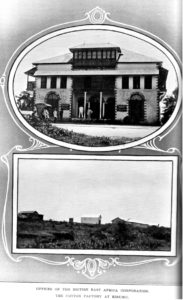The Rise and Decline of Cotton Growing in Kenya
Some pioneer settlers thought cotton might succeed in East Africa. So the British East Africa Corporation Ltd was established in 1906 with the aim of spreading the work of the British Cotton Growing Association, a body designed to encourage cotton growing in the British Empire and to establish cotton ginning factories and plantations. Some missionaries had tried growing cotton in what became Uganda with some success. It was thought that other activities would greatly assist the establishment of a cotton trade if there were associated industries such as tourism and sport and general trading. Capital of £500,000 was raised, a considerable sum in those days, which encouraged the Colonial Office to provide an annual grant for experimentation and education. The Office provided 30,000 acres for government experimental farms and granted them free of rent initially and thereafter at modest rents. The Colonial Office also lent the services of Major EHM Leggett of the Royal Engineers to be general manager of the British East Africa Corporation. He had previously been employed in South Africa on land settlement issues.
In 1907 work began by exploration of the districts which looked as if they would be promising cotton growing areas. Agriculturalists were sent into the districts to distribute seed to Africans who were given practical teaching on how to plant, look after and gather the crop. They were guaranteed a minimum price. Ginning factories were built at Malindi, Kilindini and Kisumu and experimental farms were established at Malindi, Voi, Mombasa, Kibos and Kisumu.

Top: The offices of the British East Africa Corporation. Below: The cotton factory at Kisumu.
But the seasons of 1906 and 1907 were unfavourable and this combined with a low price worldwide for cotton. The plantations in what became Kenya were not very successful, but in Uganda the soil was much more favourable and cotton growing spread rapidly. The success encouraged experimentation with different crops and rubber proved to be popular as well as sugar cane and coffee. The Corporation diversified into sport and travel and established large warehouses to cater for these activities. Cotton began to thrive in Kenya in areas near Lake Victoria. Cotton became a valuable cash crop which sustained many families in the region. Production reached a peak in 1985, when Kenya produced about 100,000 bales annually, from cotton grown by local farmers and collected by Kisumu Cotton Mills (Kicomi) for ginning. This compared with 400,000 bales in Uganda and 700,000 in Tanzania. Yet by 2014 Kenya produced only 25,000 bales and the industry is almost defunct nowadays. Cotton farmers switched to maize and other crops.
What had happened? Some people blame the industry’s poor performance on weak farmer organisations, high costs of production, inadequate quality inputs and over-reliance on rain-fed production. During the cotton boom in the late 1970s and 1980s, the government had supported the industry through the Cotton Board of Kenya, which had an organised marketing system that saw farmers get paid promptly. The board invested heavily in factories such as Raymonds and Rift Valley Textiles (Rivatex) in Eldoret, as well as Kicomi. But the textile market was liberalised in 1991 and the Cotton Board became ineffective. Second-hand clothes were imported, providing a serious challenge to local cloths. Gradually firms closed down and cotton ginning factories lay idle. Previously one of Kenya’s main exports, cotton seemed to be in its dying days. Raw textiles were, instead, purchased from Taiwan and Singapore. It is a shame that Kenya’s great potential for a cotton industry is now untapped.
www.csnicholls.co.uk

Recent Comments